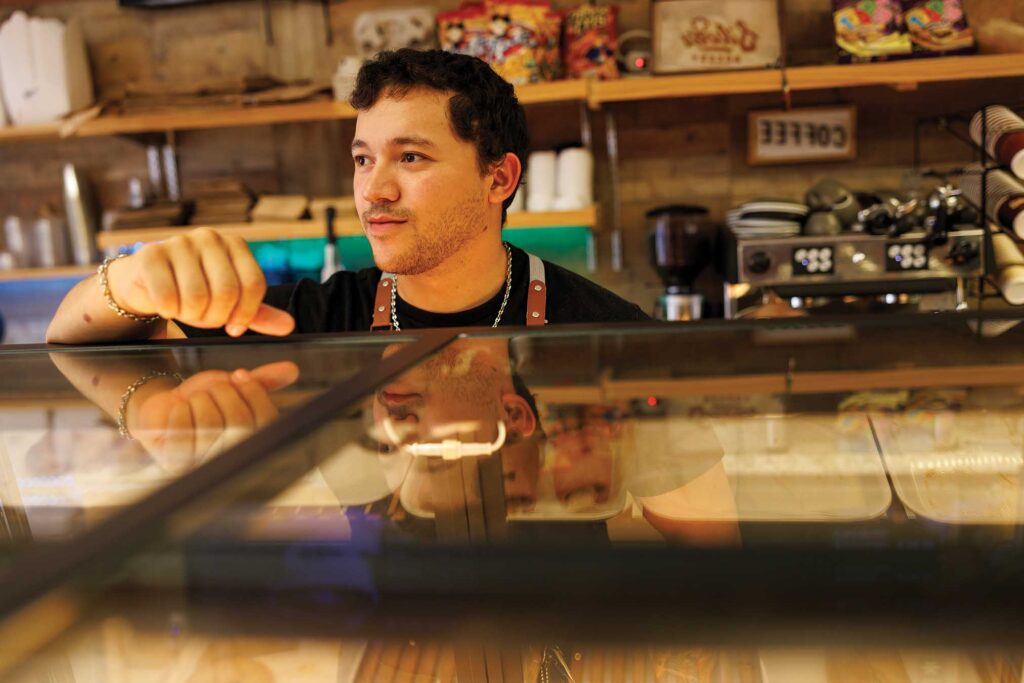For more than 30 years, Pablo Repun has danced the tango. He studied under masters Mingo Pugliese and Gustavo Naveira, taught lessons at his eponymous school in Naples, performed at Sugden Community Theatre and Naples Botanical Garden, and led student trips to his native Argentina. But not in 2020. The dance’s sensual, close embrace was at odds with COVID-19 mandates for separation. “I couldn’t work, but I’d always had a fantasy to have a coffee place,” he recalls. “In Buenos Aires, it’s part of our culture to have a coffee, sit and chat.” In October of that year, he opened Locos x Argentina—Crazy for Argentina—in a strip mall along U.S. 41. The Naples café space is small but plays big into Argentinian flavor.
Tango plays on a TV screen behind the counter. Frilly iced cakes, glossy flan and neatly crimped empanadas packed with chorizo, ground beef or pungent blue cheese populate the glass display case. Dulce de leche-filled alfajores (cookies) are stacked on cake stands, flanking an array of petite pastries, and the walls are lined with all kinds of imported goods, including the country’s nationally treasured Malbec, candies, bitter yerba mate tea and little jars of chimichurri.
Three years after opening, Pablo splits his time between the café and tango. The two seem like disparate careers, but he sees a common thread: “The bakery and coffee place is another way to show my culture.”
Throughout Southwest Florida, family-owned restaurants, cafes and bakeries serve as delicious lenses into the rich tapestry of cultures shaping our region’s culinary scene. One in five Floridians were born abroad—75 percent hailing from the Caribbean and Latin America. Aside from stone crab and citrus, the flavors of these cuisines, carried to Florida by waves of immigration, have become part of the local palate. Like New York with pizza or Texas with tacos, South Florida calls mojitos, arepas and mojo their own.
No dish epitomizes this cross-cultural culinary exchange quite like the Cuban sandwich. Different cities contest the sandwich’s exact origins, though most anecdotes agree the iconic dish originated in Florida among Cuban workers. The earliest accounts come from Tampa’s Ybor City, where the now-official recipe calls for ham, garlicky mojo roast pork, Genoa salami, Swiss cheese, pickles and yellow mustard. But, Miami fiercely contests that the sandwich originated in the city’s cafeterias, where they ditched the salami and piled the fixings on softer bread.
At Fernandez the Bull in Naples, Lazaro Figueroa doesn’t take sides in the debate. The menu has five versions of the Cuban sandwich, including the Tampa-inspired Fernandez Cuban and the Miami-style Traditional Cuban, plus a medianoche, made on sweet bread, and original variations adding lobster or bacon. Expanding the idea of what a Cuban sandwich can be was part of the evolution Lazaro spearheaded as the second generation to lead the restaurant. The restaurant—Naples’ first Cuban eatery, which opened in 1985—now has four locations across Naples, Bonita Springs and Key Largo. “The Cuban sandwich is the most popular, but we have churrasco steak, roast pork and traditional ropa vieja. They’re all the same recipes as when we opened,” he says. “There are a lot more places now that are Latin or Cuban. Cuban food is Florida.”
That wasn’t always the case. Lazaro’s uncle and restaurant cofounder Luis, ‘The Bull’ Figueroa migrated to the United States in the early 1960s as part of Operation Pedro Pan, a covert program granting more than 14,000 unaccompanied minors visas to enter the country. Over the next two decades, he worked jobs in hospitality at Miami restaurants and Naples’ LaPlaya Beach & Golf Resort before meeting Lazaro’s aunt, Raquel, who came over with Lazaro and other family members during the 1980 mass emigration Mariel boatlift. Luis and Raquel opened Fernandez the Bull’s first location in East Naples, with recipes passed down from Raquel’s mother and grandmother. “For Americans, it was something new,” says Stephanie Markham-Figueroa, who co-owns the restaurant with Lazaro. “What Luis tried to capture from the beginning was making Cuban approachable, to teach people about it. It didn’t feel like going to a Miami-style café where nobody spoke English.”
More recently, Yolanda Fornaris and Angel Figueredo opened Cubans Be Like Restaurant in a South Fort Myers strip mall, expanding the Caribbean country’s culinary foothold. Angel began working in a bakery when he was 14 to make ends meet after his father died. His menu includes Cuban sandwiches and cafecito, of course, but also other favorites like crisp pork belly chicharrones, yuca fries and vaca frita—beef slow-roasted for hours and then fried to a crisp with grilled onions. “We want people to feel at home,” Yolanda says. Part of that includes offering flavors of their own—like the Flan Maria, which gets its moniker from the shared first names of Yolanda’s grandmother and Angel’s mother.
With Cuban food firmly established in Florida’s culinary canon, doors are open for other Caribbean nations’ dishes to shine. At Dru’s West Indian Roti Shop in Fort Myers, owner Dru Churaman and her children, Tanuja and Terry, champion the flavors of their native Guyana. Dru comes in early to hand-grind the boiled yellow lentils for the intensely spiced dhal puri, roll dough into thin sheets for delicate roti, and toast spices for rich goat, chicken and chickpea curries. “Guyanese food is Indian-influenced. It is curries that are darkly seasoned. It’s deeply flavored with roti, rice and dhal,” Terry says, explaining their Indian ancestors traveled to Guyana as indentured servants in the 1800s. “Some of the words we use are Hindi; we grew up in the Indian culture,” Tanuja adds. “People think the Caribbean is just the Caribbean, but it’s so diverse. For me, Guyanese food—it’s just home.”
Before Dru’s opened in 2021, finding traditional West Indian street food sandwiches, known as doubles, required driving to the East Coast. With these golden, all-day snacks, two rounds of dough are flash-fried to order until puffed and bubbled. Cradling turmeric-scented chickpeas and brightly colored housemade condiments, including sweet tamarind sauce, emerald green cilantro chutney and fiery Scotch bonnet pepper sauce, the doubles emerge at the counter steaming hot, ready to be washed down with a bright red Guyanese Solo soda or one of Dru’s steeped sorrel drinks. There’s an art to tearing the roti and scooping the chickpea curry with one’s hands, and Tanuja and Terry are happy to explain if you’re lost. “We think about what the bigger goal is here,” Terry says. “What will we leave behind? If this person now knows about Guyanese cuisine, maybe they Google Guyana after coming here.”
A similar need for cultural representation led to the creation of Fify’s Caribbean Cuisine in Immokalee. Owners Francesca Legrand Sainvilus and Rosica Legrand’s parents emigrated to the United States from Haiti in the 1970s. They ran a grocery store, Legrand Caribbean Market, in the heavily immigrant community for more than 25 years. “There were all-American burgers and Spanish food, but there were no Caribbean restaurants, even though it’s highly populated by Haitians,” Francesca recalls. So, in 2016, the sisters opened Fify’s and filled the menu with their mom’s recipes firmly rooted in labor-intensive tradition. One staffer is dedicated just to trimming and scrubbing meat, a traditional Haitian process involving scouring each cut of pork or chicken with salt and citrus. The practice likely began as a way to purify meat before refrigeration. Scouring is no longer necessary for food safety; it helps tenderize tough cuts and skipping the process would change the authenticity and flavor of the dish.

In addition to Haitian standards, like griot (golden-fried cubes of slow-roasted pork shoulder) and diri djon-djon (rice stained black by the smoked, dried namesake mushrooms native to Hispaniola), Fify’s also serves its interpretation of dishes from other Caribbean cultures. On any given week, the restaurant has up to 12 rotating variations on rice—an important regional staple—which might include Jamaican red bean rice or Dominican yellow rice with pigeon peas. “I think of it the same way you would a Disney movie. For years, we never had a Black Disney princess, and we struggled with identity because we didn’t have anything beautiful that looked like a Black woman,” Francesca explains. “I feel I belong to this community because I see my food here.” In 2020, the James Beard Foundation agreed. The organization awarded Fify’s one of 60 grants distributed nationwide to help keep restaurants preserving Black and Indigenous culture afloat during the pandemic.
In North Naples, find representation at Silva’s Bakery. The multigenerational pastry shop is run by Luz and Marcelo Silva, who owned a bakery in their native Venezuela for more than 30 years, and their grandson, David. “When we came to Naples about 11 years ago, it was my grandmother’s dream to open a bakery,” David says. “There’s not a big bakery culture here. Everything is so mechanized. You go to the supermarket to get your loaf of bread.”
Six days a week, Marcelo and Luz arrive at the 2-year-old bakery at 5 a.m. to shape mini baguettes, bake sticky buns topped with mild queso de mano, fill cachitos (stuffed crescent rolls) with salty ham and bacon, and prep rounds of corn masa dough to be grilled for crispy-edged arepas. David is developing the shop’s coffee program, perfecting the science of roasting beans in-house with the help of barista friends. “Growing up in South America, we definitely value our coffee. I gather beans from Mexico, Brazil, Guatemala and Costa Rica,” he says. “The coffee is no more than three or four days old by the time we brew it. The texture is amazing; it’s naturally sweet .”
At Lima Restaurant in East Naples, the gateway into Peruvian cuisine is pisco. Owners Dario and Amanda González Zúñiga carry several labels of the brandy, which can display different characteristics based on the grapes it’s distilled from. “Pisco is Peru. That’s a saying they put on a lot of bottles,” Amanda says. “You can do tastings of the different grape varietals. No one else is giving it attention locally.”
Dario, born and raised in Lima and studied at the city’s fine dining school, Le Cordon Bleu, is particularly passionate about delving into the provenance and significance of Peruvian ingredients. And the restaurant reflects the fine-dining sensibilities applied to traditional cuisine in the city. “Lima has been named the gastronomic capital of the world. The No. 1 restaurant in the world is there,” he says, referring to chef Virgilio Martínez’s Central, which nabbed the top spot in the 50 Best Restaurants’ rankings in June. “It’s not just my goal to make a Peruvian restaurant. The idea is to open one that is contemporary with the movement that is going on in Lima right now.”
To that end, Dario and Amanda visit Lima annually and incorporate current trends into the menu. As the city embraces its multicultural background, Nikkei cuisine has become en vogue. The Japanese-influenced Peruvian dishes draw from the Japanese diaspora in the late 19th century, which saw waves of immigrants settling in Peru. At Lima, the cuisine is showcased in the Nikkei ceviche, which is marinated with soy sauce and aji amarillo leche de tigre. Unlike traditional Peruvian ceviches, which marinate for 30 minutes or more, Lima’s versions take only five minutes, preserving the freshness of the fish in keeping with Japanese tradition. Dario recently embraced Peru’s booming craft beer scene, too, adding Magic Quinoa Pilsner from Cervecería BarBarian, Lima’s first major craft brewery, to the menu. “I’m proud to showcase my Peruvian heritage through food,” Dario says. “For people who have not yet been to Peru, the idea is to make them travel from the table through the food and experience new flavors and ideas, which is, to me, the absolute best kind of culture exchange.”



